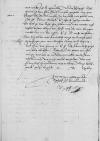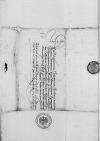 GStAPK, HBA, C1, No. 982, f. 1r
GStAPK, HBA, C1, No. 982, f. 1r
Durchlauchtiger hochgeborner Fürst, / hochgunstiger lieber her und freundt. / Unsere freuntliche und vleiswillige dienste zuvoran. /
Wir haben negst vom ⌊Braunsberge⌋ den XXVIII Iulii E(urer) F(urstlichen) D(urchlauch)t eigen ⌊⌋ zu ⌊Konigsberg⌋ den XX desselbten monats an uns ausgangen / was dozumal von notten / ⌊⌋, / doneben auch die zeittungen die uns do von koniglichem hoffe geworden E(urer) F(urstlichen) D(urchlauch)t zugeschickt, / der zuvorsicht, / das die bei unserm handschreiben E(urer) F(urstlichen) D(urchlauch)t durch iren paper damaged⌈[n]n paper damaged⌉ lauffenden sein zukommen. /
Und dieweil wir wissen / das solcher zeittunge mitteilung E(urer) F(urstlichen) D(urchlauch)t nicht ungefellig sein, / und dieser bott uns vorgefallen, / hab wir nicht mugen nachlassen / diese hie eingelegte, / wie es vor kortzen tagen zum ⌊Kesmarckte⌋ in ⌊Hungern⌋ / und was uffm ⌊Rakus⌋ vorhandelt / E(urer) F(urstlichen) D(urchlauch)t zu ubersenden, / aus welchem klerlich das alte sprichwort / cf. AGRICOLA No. 19 ⌊“untrew schlahe sein eigen herren”cf. AGRICOLA No. 19 ⌋
/ wirt befunden / etc. Von koniglichem hoffe aus ⌊Litten⌋ / wirt uns geschrieben / das ⌊ko(niglich)e m(ajeste)t⌋ unser allergnedigster her / widderumb zu muglicher gesuntheit, / solchem alter nach, / sei kommen. / Got der Almechtige wold ir m(ajeste)t zu langen gezeitten dorin erhalten. / Amen. /
Die junge ⌊ko(niglich)e m(ajeste)t⌋ auch unser aller gnedigster herr / mit ⌊beiden konigin⌋ und ⌊schwestern⌋ / unser gnedigsten frauen / ist auch zu ⌊Breske⌋, / Got hab lob / mit sonderer lieb und freud in guter gesuntheit, / die wir iren maiesteten von Got zu langen zeitten wunschen und bitten. /
Der landtstag in ⌊Litten⌋ het sich noch vor zehen tagen nicht angefangen, / wie wol viel herren  GStAPK, HBA, C1, No. 982, f. 1v und volcks sich do gesamlet. / Das posnische bishthumb ist dem hern ⌊Paulo cantzler ⌋gegeben, / das gros siegel dem hern on the margin⌈hernhern on the margin⌉ undercantzler. / In des stelle, / wie gleubt wirt, / soll her ⌊Thome Sobotzki⌋ ko(nigliche)r schenck / gesatzt werden. / So viel ist uns diese zeit zukommen. / Wir warten noch teglich unsers botens von hoffe, / was der wirt brengen wolle wir mit den ersten E(urer) F(urstlichen) D(urchlauch)t nicht vorhalten, / dan derselbten viel freuntliche dienst und wilferigkeit zuerzeigen / sein wir alwegen willig und begirig / und thun uns hiemit in E(urer) F(urstlichen) D(urchlauch)t freuntliche gunst mit vleis bevelhen, / bittend / so die etwas von zeittungen / und wie es mit ⌊Dennemarcken⌋ vorlassenn / uberkommen, / uns nicht wolde vorhalten, / das wir freuntlich zuvordienen uns erbieten. /
GStAPK, HBA, C1, No. 982, f. 1v und volcks sich do gesamlet. / Das posnische bishthumb ist dem hern ⌊Paulo cantzler ⌋gegeben, / das gros siegel dem hern on the margin⌈hernhern on the margin⌉ undercantzler. / In des stelle, / wie gleubt wirt, / soll her ⌊Thome Sobotzki⌋ ko(nigliche)r schenck / gesatzt werden. / So viel ist uns diese zeit zukommen. / Wir warten noch teglich unsers botens von hoffe, / was der wirt brengen wolle wir mit den ersten E(urer) F(urstlichen) D(urchlauch)t nicht vorhalten, / dan derselbten viel freuntliche dienst und wilferigkeit zuerzeigen / sein wir alwegen willig und begirig / und thun uns hiemit in E(urer) F(urstlichen) D(urchlauch)t freuntliche gunst mit vleis bevelhen, / bittend / so die etwas von zeittungen / und wie es mit ⌊Dennemarcken⌋ vorlassenn / uberkommen, / uns nicht wolde vorhalten, / das wir freuntlich zuvordienen uns erbieten. /
 GStAPK, HBA, C1, No. 982, f. 3v
GStAPK, HBA, C1, No. 982, f. 3v
 GStAPK, HBA, C1, No. 982, f. 1r
GStAPK, HBA, C1, No. 982, f. 1r
 GStAPK, HBA, C1, No. 982, f. 1v und volcks sich do gesamlet. / Das posnische bishthumb ist dem hern
GStAPK, HBA, C1, No. 982, f. 1v und volcks sich do gesamlet. / Das posnische bishthumb ist dem hern 

